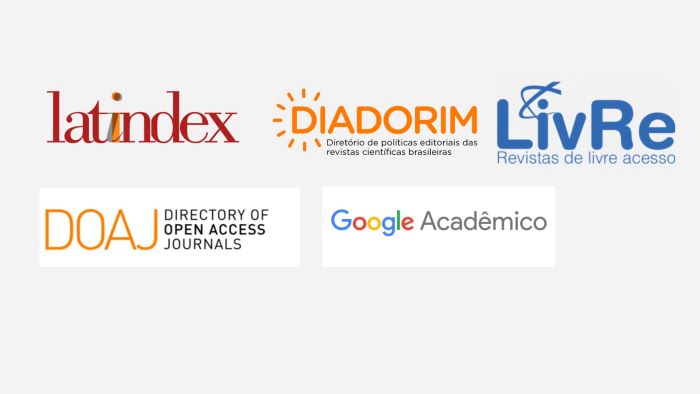Environmental education classes in the student garden: the geography discipline with its mechanisms providing theorization and practices in the final years of elementary school
DOI:
https://doi.org/10.5418/ra2024.v20i41.13589Keywords:
educação ambiental, recorte geográfico, horta estudantil, experimentaçõesAbstract
Currently, the term Environmental Education (EA) is widely disseminated in the international and national media. Thus, this work aimed to unite theories and practices about AE using the student garden with the students of elementary II as a geographic cut. As methodological procedures, a literature review was carried out about AE and The Importance of Having a Garden at School. The experiments included maps and plans of the study area, construction of histogram, numerous images of the practices developed by the students. The following tools were used: rakes, hoes, scissors for pruning plants, pliers for pruning vegetables, gloves for spraying, cell phones for recording practices. Geography and its tools were fundamental to consolidate the work. Large-scale productivity was not the focus of this work, but the feedback of practical knowledge.
Downloads
References
BRASIL, (1998). Parâmetros Curriculares Nacionais: terceiro e quarto ciclos do Ensino Fundamental –Temas Transversais. Brasília: MEC/Secretaria de Educação Fundamental.
BRASIL. MEC. Panorama da educação ambiental no ensino fundamental. Brasília: MEC/SEF, 2001.
CAPARRÓS, R. P. Saber Ambiental: saber e complexidade ambiental. SAO BERNARDO DO CAMPO/SP, 2010. Disponível em: http://www.crbiodigital.com.br/01/ricardocaparros?nprnc=038097099061080095 84101115101115038116120116061051048055055051055051048. Acesso em: 23/09/ 2019 às 10h05min.
CUBA, M. A. Educação Ambiental nas Escolas. ECCOM, v. 1, n. 2, p. 23-31, jul./dez., 2010. Universidade de FATEA, Lorena/SP.Disponível: http://fatea.br/seer/index.php/eccom/article/viewFile/403/259Acesso em: Acesso em: 31/12/2019 às 20h15min.
GADOTTI, M. “Perspectivas atuais na educação”. Instituto Paulo Freire, São Paulo- SP, 2000. Disponível em: http://www.scielo.br/pdf/spp/v14n2/9782.pdf. Acesso em: 10/06/2019 às 21h10min DOI: https://doi.org/10.1590/S0102-88392000000200002
GALLO, S. Transversalidade e meio ambiente. Ciclo de palestras sobre meio ambiente. Secretaria de Educação Fundamental – Brasília: MEC; SEF, 2001. p. 56.http://interacao2008.pbworks.com/f/transversalidade%20e%20meio%20amb iente.pdf. Acesso em: 23/09/2019 às 21h12min.
LEFF, H. Complexidade, Racionalidade Ambiental e Diálogo de Saberes. Educação & Realidade, 17-24. Set/dez. 2009. Disponível em: http://seer.ufrgs.br/educacaoerealidade/article/viewFile/9515/6720. Acesso em: 23/12/ 2019 às 21h23min.
LIMA, G. F. C. In: Identidades da educação ambiental brasileira. Ministério do Meio Ambiente, 2004. Disponível em: http://www.mma.gov.br/port/sdi/ea/og/pog/arqs/livro_ieab.pdf. Acesso em: 10/09/2019 às 14h25min.
MEDEIROS, A. B., et al. A Importância da educação ambiental na escola nas séries iniciais. Revista Faculdade Montes Belos, v. 4, n. 1, set. 2011. Disponível: http://www.terrabrasilis.org.br/ecotecadigital/pdf/aimportancia-da-educacao-ambiental-na-escola-nas-series-iniciais.pdf. Acesso em: 10/09/2019 às 13h32min.
MEIRA, Z. A. A contribuição do Curso de Letras para a Educação Ambiental. Especialização em Docência para o Magistério em Itaituba, PA. Graduada em Letras, 2010. Disponível em: http://www.webartigos.com/artigos/acontribuicao-do-curso-de-letras-para-a-educacao-ambiental/45155/. Acesso em: 10/09/2019 às 13h35min.
MORGADO, F.S. A horta Escolar na Educação Ambiental e Alimentar: experiência do Projeto Horta Viva nas Escolas Municipais de Florianópolis. Florianópolis (SC). 2006 (Monografia).
ORGANIZAÇÃO MUNDIAL DA SAÚDE. O papel da horta na escola. Publicações OMS, 1997. Disponível em: https://www.who.int/eportuguese/publications/pt/. Acesso em: 10 fev. de 2018.
REIGOTA, M. Meio ambiente e representação social. 7 ed. São Paulo: Cortez, 2007.
SATO, M.; CARVALHO, I. Educação ambiental – pesquisa e desafios. Porto Alegre: Artmed, 2005.
SAUVÉ, L. Uma cartografia das correntes em Educação Ambiental. In: SATO, M. E CARVALHO, I. Educação Ambiental: pesquisa e desafios, ARTMED, 2005.
SILVA, M.E.M.P; PATON, T. M. Vida saudável: nutrição, nutrientes, alimentação e saúde. USP São Paulo, 1999.
SILVA, R.C.S.; SANTOS, T. Alimentação Escolar no Estado do Rio de Janeiro. Anais do XV Congresso Brasileiro de Nutrição. Brasília, 1998.
Site:
WWW.GOOGLE EARTH.COM.BR. Acessado dia 23/11/2019 às 21h30min.
Downloads
Published
How to Cite
Issue
Section
License
Autores que publicam nesta revista concordam com os seguintes termos:Autores mantêm os direitos autorais e concedem à revista o direito de primeira publicação, com o trabalho simultaneamente licenciado sob a Creative Commons Atribuição-NãoComercial-CompartilhaIgual 3.0 Brasil que permitindo o compartilhamento do trabalho com reconhecimento da autoria do trabalho e publicação inicial nesta revista.
Autores têm autorização para assumir contratos adicionais separadamente, para distribuição não exclusiva da versão do trabalho publicada nesta revista (ex.: publicar em repositório institucional ou como capítulo de livro), com reconhecimento de autoria e publicação inicial nesta revista.
Autores têm permissão e são estimulados a publicar e distribuir seu trabalho online (ex.: em repositórios institucionais ou na sua página pessoal) a qualquer ponto antes ou durante o processo editorial, já que isso pode gerar alterações produtivas, bem como aumentar o impacto e a citação do trabalho publicado (Veja O Efeito do Acesso Livre em http://opcit.eprints.org/oacitation-biblio.html.)
Authors who publish with this journal agree to the following terms:
Authors retain copyrights and grant the Journal the right of first publication with the work simultaneously licensed under a Creative Commons Atribuição-NãoComercial-CompartilhaIgual 3.0 Brasil that allows others to share the work with an acknowledgement of the work's authorship and initial publication in this Journal.
Authors are permitted to enter into separate, additional contractual arrangements for the non-exclusive distribution of the Journal's published version of the work (e.g., post it to an institutional repository or in a book chapter), with an acknowledgement of authorship and initial publication in this journal.
Authors are permitted and encouraged to publish and share their work online (e.g., in institutional repositories or on their website) prior to and during the submission process, as it can lead to productive exchanges, as well as increase the impact and citation of published work (See The Effect of Open Access - http://opcit.eprints.org/oacitation-biblio.html.)




